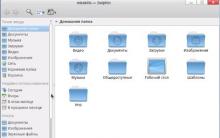There are thousands or even tens of thousands of products in modern online stores. It is simply impossible to manually launch contextual advertising for the entire range of products, so Yandex and Google offer users to use product feeds (they are also called YML or XML feeds).
A product feed is a systematized and structured list of data about product offers or services. As a rule, the main product feed formats are CSV, TSV, XLS, XLSX. The rows indicate the names, the columns - the attributes of goods or services.
Product feed example:
Why you need a feed
- Create and quickly adjust a large number of advertisements.
- Automatically adjust advertisements depending on the presence or absence of certain goods in the warehouse (displaying only relevant ads).
- Filter ads by categories, prices and other parameters.
- Add additional product features.
How to use a product feed in Yandex.Direct
When you run dynamic ads on the search network, their content may change based on the content in your feed. That is, ads are easy to update. This largely explains the high conversion of such ads.
How to create a dynamic feed ad




In the future, the campaign can be optimized, for example, using the Get Direct service.
Yandex allows you to create dynamic ads only on a limited range of topics:
- electronics and accessories;
- Appliances;
- industrial equipment;
- clothes;
- furniture;
- garden;
- sporting goods;
- Construction Materials;
- children's products;
- tires and wheels;
- cosmetics and perfumery;
- Property For Sale;
- sale of new cars;
- sale of used cars;
- sale of air tickets;
- hotels, inns.
How to use a feed in a smart banner campaign
To get access to smart banners, you need to contact the Yandex.Direct support service, since this toolkit is still at the beta testing stage. The essence of this type of ad is to launch banners based on data from the feed. Smart banners, like dynamic ads, have high conversion rates. Pay per click.
Smart banner example:

When creating a campaign with smart banners, you need to specify "Feed" as the data source, select the desired feed from the list and add banners. You can upload no more than 50 banners, while one banner can be linked to several positions in the feed.
Read more about how to set up a campaign with smart banners. in a case.
It should be added that smart banners consist of two parts: constant and variable.
The permanent part of the smart banner includes:
- advertiser's logo;
- special offer;
- a link leading from the special offer to the advertiser's website;
- information about promotions and discounts;
- call to action button.
The changing part includes:
- image of a product, work or service;
- product offer;
- the old price of a good, work or service;
- the new price of a product, work or service;
- the amount of a discount on a product, work or service.
- retail goods;
- Property For Sale;
- cars sale;
- sale of auto parts;
- hotels, inns;
- sale of air tickets.
How to use a feed in Google Ads
Dynamic remarketing and dynamic display ads allow you to show ads for products that are of interest to a particular user. In the case of dynamic remarketing, ads can be targeted, for example, to users who have previously visited the site. Of course, when creating such advertising campaigns, a product feed is also used.
How to Create Dynamic Ads for Google Search Ads
To create a dynamic search campaign, you need to set the new campaign type to "Search Network Only" - "Dynamic Search Ads":

In this type of campaign, the feed allows you to target specific web pages. To add a feed, select "Commercial data" - "Page feed":


Ready! There are no subject restrictions.

2. Click "Download feed":


4. Upload the feed XML file.
During the campaign creation process, we can link the remarketing terms to the previously uploaded feed.
How to use feed in product ads

This type of ad is implemented using Google Merchant Center. So far, creating shopping ads is available not in all countries.
To create a shopping ad campaign, you need to:
- create a Google Merchant Center account;
- create a Google Ads account;
- upload product feed to Google Merchant Center;
- establish a link between Google Merchant Center and Google Ads;
- verify the rights to the site URL.


Select the download type and upload the file. After that, click "Continue":


There are no subject restrictions.
How dynamic ads work - Hamleys toy store case study
Result:
From 07/01/2017 to 07/31/2017, an advertising campaign was launched using an XML feed for the Hamleys offer. At the same time, all settings in the tested advertising campaigns were identical. Campaigns differed only in the method of generating ads.
The result of running dynamic ads with a product feed:
conclusions
The product feed is used:
- When running dynamic ads on the Yandex and Google search networks.
- In campaigns with smart banners in Yandex.Direct.
- In Google Ads dynamic display campaigns.
- In product advertising, using the Google Merchant Center.
The feed allows you to unlock the additional potential of contextual advertising. In addition, the ability to set up and launch ads with a product feed makes it more “flexible” and effective.
These tools in Google have been around for a relatively long time. At Yandex, they are in open beta testing and are likely to change. However, already now, advertising campaigns with product feeds have proven themselves well.
A data feed is a file with detailed information about your products. All information in it is represented by attributes. Some of them, like condition [state] and availability [availability] , can only have fixed values. For others, such as id [identifier] and title [title] , the value is given in relatively free form. Attributes are divided into mandatory and optional. If you provide complete and accurate information in them, it will be easier for users to find your products.
Product data needs to be updated periodically. Read more about this and other rules written.
You must create a Merchant Center account before uploading product information. Data can be added as feeds or via the Google Content API for Shopping, or imported from an ecommerce platform. If you are not well versed in the API, it is better not to use this option.
Data feeds
A feed is a file with detailed information about products. The information in it is presented in the form of attributes, with the help of which buyers can easily find what they need.
Google Content API for Shopping (for advanced users)
With the Google Content API for Shopping, you can manage structured data uploaded to Google and use it in services such as Google Search and Google Shopping. You can use the API to query products, and add, update, and delete products in your Google Merchant Center account.
The Google Content API for Shopping is designed for software developers who need to link their apps to Google Shopping. That's why you need to have sufficient technical knowledge and experience in application programming to use this API.
Supported file formats
If your source file doesn't meet the requirements of the specification, use the advanced features of the Merchant Center to complete the details with the missing attributes and values.
Advanced features
Advanced features in section Feeds allow you to download product information from multiple sources and convert it according to the specification. With their help, you can also target the already added data to several countries.
Use advanced Merchant Center features to update primary feeds with secondary feeds, copy product details for new target countries, and set up feed conversion rules.
Yandex.Direct offers a number of tools to help automate the creation of contextual advertising. In particular, it will be useful for online stores to create product feeds, i.e. a kind of database of products that, with certain manipulations, can be shown in Yandex.Direct ads without additional tedious manual work.
What are feeds in Yandex.Direct
Feeds are primarily used to create and . That is, such types of ads that provide a template where you can simply substitute the names of goods, price, and some other data, and create ads for hundreds or thousands of products in a couple of clicks.
A product feed is a file in one of the following formats:
- YML (Yandex Market Language) - a format created specifically for
Using a feed is very convenient, because it makes it easier to update information on the availability of goods, prices, promotions, add product characteristics, group ads depending on the product category.
How to create a feed for Yandex.Direct
As mentioned, feeds work for dynamic ads and smart banners, which have their own restrictions on product topics. Perhaps the number of topics will expand over time.
We will analyze the creation of a feed for retail.
The feed for retail products must be in YML format (for other topics, CSV or XML is possible). It, like an XML document, uses one element:
There are several ways to create a YML file. We recommend trying out an automated, using the service mysitemapgenerator.com. Here you will need to go to the section yml generator.

As seen in the example above, there is a series parameters, which can be entered into an XML file (or YML). For retail, for example, the list looks like this.
As you can see, there are many settings. Each topic has its own list with its own characteristics, and the full set of parameters can be found in Yandex Help.
Creating Dynamic Feed Ads

When uploading a feed, select its type and enter a name.

Below we provide instructions for creating a tab-delimited data feed. If you're more comfortable working in a text editor, skip the steps below, but make sure your feed meets the format requirements listed at the bottom of the page. You can also create a feed using Google Sheets. Read about how to do this. To create an XML feed, use the following instructions: , .
Data feed examples
You can see examples of feeds in TXT and XLS formats. Please note that the XLS file is provided as an example only. Google does not support feeds in this format.
Create a data feed
Step 1: Open a spreadsheet program
In spreadsheet programs such as Microsoft Excel, you can easily create a data feed and convert it to the desired format.
Step 2: Create a title bar
In the first row of the spreadsheet, enter the names of the attributes that describe the product (one in each column). In order for your products to appear on Google Shopping, you must provide information about them in a strictly structured way. Two types of attributes will help you with this:
- mandatory;
- recommended.
Goods for which the required attributes are not specified will not be processed. Recommended attributes can be omitted. However, we recommend that you do this so that your products appear more often in search results. Check out the title bar example below for the required attributes for the selected target country.
Step 3: Enter product details
In the lines below the heading, enter information about the goods in accordance with the selected attributes. Please note that each product should be assigned a separate line, and information about it should be distributed in the appropriate columns. For example, a product description should be in a column with the heading "description". If there is no attribute value for this product, do not fill in the cell.
Step 4: Convert the spreadsheet
Most spreadsheet programs allow you to export data to a tab-delimited text file. This is the file that should be sent to the Google Merchant Center. You can create it in several ways. Below are two of them. You can create it in several ways. Below are two of them.
- In Microsoft Excel save the spreadsheet as a tab-delimited text (.txt) file. To do this, select Save as... on the menu File and select the required format. drop down menu File type select Text files (tab delimited) (*.txt).
- With Google Sheets you can upload any of your spreadsheets to the Merchant Center or set up regular data uploads. about this feature. In addition, you can download or upload the table by going to the menu File by opening the item Export and selecting the .txt extension. The tab-delimited text file will open in a new window. Select Save as... on the menu File browser to save this file as a text file with a .txt extension.
If you have already registered your feed with your Google Merchant Center account, use the same name as the specified file.
Step 5: Submit your data feed
Make sure the generated file meets the format requirements below and .
Format Requirements
- The file must contain plain text with a tab delimiter.
- The first line in the file must be a header consisting of attribute names separated by tabs.
- Each product must be on a separate line, and attribute values must be separated by tabs.
- Lines must not end with a tab character.
- Attributes should not contain tabs or line breaks.
- For group attributes, such as "tax" (tax) and "shipping" (shipping), sub-attributes should be specified through a colon. Read more about taxes and shipping at.
- If the attribute accepts multiple values, specify them separated by commas, such as "blue, green, red". If a comma is included in the attribute value and cannot be used as a separator, use a backslash "\". For more information, see the feed specification. Note that for some attributes, such as "identifier" (id) or "description" (description), you can specify only one value.
Was this article helpful?
How can this article be improved?
Hello everyone!
Yandex.Direct feeds are a real lifesaver for large online stores, allowing you to automate the creation of ads in Yandex.Direct. And how to do it is a matter of technology ..
On the Internet, there are a huge number of online stores with a large assortment of which you need to drive traffic in order to get sales. However, one big, big problem pops up here - how to advertise so many product items in Yandex.Direct? Do you really have to select keywords for each product and write ads? Not! It is enough to use what is below and.
A bit of history
In the past 2016, Yandex released such interesting things as dynamic ads and feed management in the BETA version. They were created to work with sites containing information about a huge range of services or goods. With these innovations, Yandex has made life much easier for the owners of such sites who would like to advertise in Yandex.Direct.
What is a feed?
A feed is a file containing information about a product or service. It can be in several formats:
- YML (Yandex Market Language). A specially developed file format for Yandex.Market;
- And a couple of obscure ones - GZ and TSV;
- You can also use compressed ZIP files.
All these formats are used by Yandex.Direct and Market to obtain information that is displayed in ads. Of all the above, the first two are most preferred.
What is a feed for?
As you already understood, feeds are needed to convey information about the assortment of an online store, but how to use this information in Yandex.Direct. Very simple! Use dynamic ads (k). However, it should be remembered that this type of ad serves solely as an addition to already running advertising campaigns, because it is still at the Beta testing stage.
How to create a feed?
For beginners who launch ads in the Yandex contextual advertising system, this question is an edge one, since there is no clear and understandable information on how to create a feed. So I, in search of information for this lesson, went through a lot of sites, watched several videos, but did not find anything suitable, since apparently creating a feed for most webmasters is not something difficult.
I had to think a little with my head, when a bright idea immediately came to mind - if you can use the YML (XML) file format in Yandex.Direct, and Yandex.Market is a popular thing, then there is some kind of generator or template for such files. I turned out to be right and came across an XML sitemap generator that can generate YML - MySiteMapGenerator.
With it, you can very easily create a file for both Yandex.Market and Direct:

When you open the generated YML file, you will see the following: 
A set of code with all data about products whose pages were indexed by the YML generator. All this is called the Yandex.Direct feed, or rather Yandex.Market.
Other ways to create a feed:
- With the help of special plugins for your CMS. For example, for CMS WordPress there is a Market Explorer plugin. If you have a different content management system, then look for;
- Excel can create a CSV file, but is less preferred than YML (XML).
What to do with a feed in Yandex.Direct?
After you have created a feed, you will need to upload it for verification in Yandex.Direct. You can do it like this:

Additional information about feeds can be found in Yandex Help, here is the link.
We kindly request: if you liked the material and helped in solving the problem, please share the link on social networks.
See you soon!
Test for lesson number 124
Time limit: 0
Navigation (job numbers only)
0 of 5 tasks completed
Information
Check the knowledge gained in the lesson!
You have already taken the test before. You cannot run it again.
Test is loading...
You must login or register in order to start the test.
You must complete the following tests to start this one:
results
Correct answers: 0 out of 5
Your time:
Time is over
You scored 0 out of 0 points (0 )
- With an answer
- Checked out
Task 1 of 5
1 .
Number of points: 1What is a feed?
Task 2 of 5
2 .
Number of points: 1Selects a feed file format that is not allowed in Yandex.Direct:
Task 3 of 5
3 .
Number of points: 1What is a feed for?











Personal account of the insured person
Automatic identification system Joint use of AIS with an electronic chart system
Wargame: Red Dragon not starting?
Sad escobar "The face of the judicial system of Ukraine"
ROME Total War - how to unlock all factions?